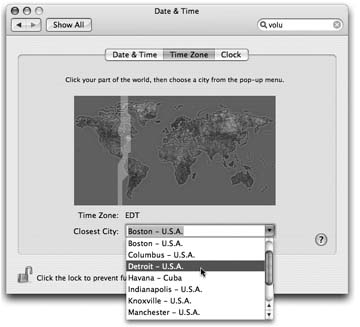9.10. Desktop Screen Saver
| < Day Day Up > |
9.9. Date & TimeYour Mac's conception of what time it is can be very important. Every file you create or save is stamped with this time, and every email you send or receive is marked with this time. As you might expect, setting your Mac's clock is what the Date & Time pane is all about. 9.9.1. Date & Time TabClick the Date & Time tab. If your Mac is online, turn on "Set date & time automatically," and be done with it. Your Mac sets its own clock by consulting a highly accurate scientific clock on the Internet. (No need to worry about Daylight Saving Time, either, as the time servers take that into account.)
Tip: If you have a full-time Internet connection (cable modem or DSL, for example), you may as well leave this checkbox turned on, so that your Mac's clock is always correct. If you connect to the Internet by modem, however, turn off the checkbox, so that your Mac won't keep trying to dial spontaneously at all hours of the night. If you're not online and have no prospect of getting there, you can also set the date and time manually. To change the month, day, or year, you can click the digit that needs changing and then either (a) type a new number or (b) click the little arrow buttons . Press the Tab key to highlight the next number. (You can also specify the day of the month by clicking a date on the minicalendar.) To set the time of day, use the same technique ”or, for more geeky fun, you can set the time by dragging the hour , minute, or second hands on the analog clock. Finally, click Save. (If you get carried away with dragging the clock hands around and lose track of the real time, click the Revert button to restore the panel settings.) Tip: If you're frustrated that the Mac is showing you the 24-hour "military time" on your menu bar (that is, 17:30 instead of 5:30 p.m .) ”or that it isn't showing military time when you'd like it to ”click the Clock tab and turn "Use a 24-hour clock" on or off.Note, however, that this affects only the menu bar clock. If you'd like to reformat the menu bar clock and all other dates (like the ones that show when your files were modified in list views), click the Open International button at the bottom of the Date & Time pane. Once there, click the Formats tab. There you'll see a Customize button for Times, which leads you to a whole new world of time-format customization. You can drag elements of the current time (Hour, Minute, Second, Millisecond, and so on) into any order you like, and separate them with any punctuation. 9.9.2. Time Zone TabYou'd be surprised how important it is to set the Time Zone for your Mac. If you don't do so, the email and documents you send out ”and the Mac's conception of what documents are older and newer ”could be hopelessly skewed. Teach your Mac where it lives using the Time Zone map, as shown in Figure 9-6. 9.9.3. Clock TabIn the Clock pane, you can specify whether or not you want the current time to appear, at all times, at the right end of your menu bar or in a small floating window, whose transparency you can control with the slider here. You can choose between two different clock styles: digital (3:53 p.m.) or analog (a round clock face). You also get several other options that govern this digital clock display: the display of seconds, whether or not you want to include designations for a.m. and p.m., the day of the week, a blinking colon , and the option to use a 24-hour clock. Tip: At the bottom of the dialog box, you'll find a feature called "Announce the time." At the intervals you specify, the Mac will speak, out loud, the current time: "It's ten o'clock." If you tend to get so immersed in "working" that you lose track of time, Mac OS X just removed your last excuse . And by the way, your menu bar clock always shows the current time . When you need to know today's date , just click the clock. A menu drops down revealing the complete date. The menu also lets you switch between digital and analog clock types and provides a shortcut to the Date & Time preferences pane. Tip: Attention Unix geeks : You can also set the date and time from within Terminal (Chapter 16). Use sudo (Section 17.1.5.1), type date yyyymmddhhmm.ss , and press Enter. (Of course, replace that code with the actual date and time you want, such as 200504051755.00 for April 5, 2005, 5:55 p.m.) You might find this method faster than the System Preferences route.
|
| < Day Day Up > |
EAN: 2147483647
Pages: 506
